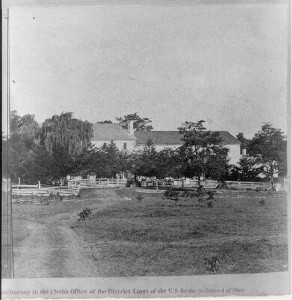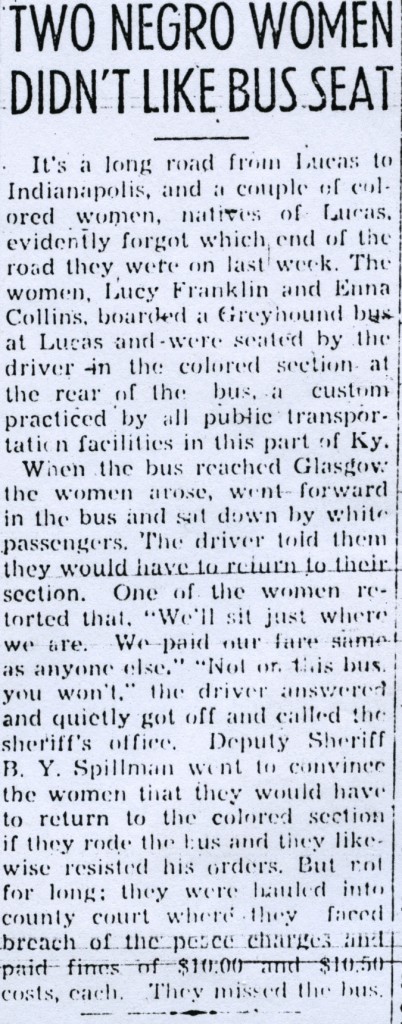Author Archives: Nancy Richey
Hale’s Recollections of Confederate Guerilla “Champ Ferguson”
Champ Ferguson was a personal enemy of Hale and destroyed his home and business. The state of Kentucky, John Hunt Morgan, Alvan Cullom, the killing of “Little Fount Zachery”, Henry Sublits(sic), loss of much property and the loyalties of Ferguson are noted. And that he was worthy of execution by hanging. “The military trial, held in Nashville, Tennessee, lasted from July to October 1865. Ferguson was sentenced to be hanged; he was denied the opportunity to provide a defense on his behalf, and the sentence was carried out on October 20, 1865. Ferguson’s body was turned over to his wife and daughter, who fulfilled his last request which was to be buried at his home in White County, Tennessee, on a branch of Calfkiller Creek.”
Hale would leave Tennessee and live out the rest of his life in New Hampshire having grown tired of being a “damn Yankee.”
See http://www.ajlambert.com/history/ct_hus.pdf
For more information on Champ Ferguson and the Civil War, visit WKU’s Department of Library Special Collections, or contact spcol@wku.edu. For more collections, search TopSCHOLAR and KenCat.
Comments Off on Hale’s Recollections of Confederate Guerilla “Champ Ferguson”
Filed under General, Manuscripts & Folklife Archives, New Stuff
Rare Shaker Timeline/Chart
A recent purchase by the Department of Library Special Collections bolsters the significant Shaker holdings in Kentucky Library Research Collections. This two-piece timeline map/chart is titled, “Genealogical Chronological and Geographical Chart Embracing Biblical and Profane History of Ancient Times from Adam to Christ.” The map was produced by Jacob Skeen of Louisville, Kentucky in February 1887 as an educational tool to reinforce the traditional Christian validity of Shaker communities and to arrest the decline of the United Society of Believers in Christ’s Second Appearing or as they were more commonly known, the Shakers. Elder Alonzo Hollister of the Mount Lebanon, New York community wished to show that Shaker orthodoxy had continuity with scripture and the traditional church. It was also a grasping attempt to reconcile their beliefs with a fast changing, progressive worldview. Copyrighted 1887, the detailed chart with many sub-charts purports to show locations and relationships of humanity, the Church and the Devil. W.F. Pennebaker of the community at Pleasant Hill, Kentucky also participated in the publication of this lithograph. David Rumsey, a world renowned map collector and the founder of the David Rumsey Map Collection notes that “although researched, designed, drawn, and copyrighted by Jacob Skeen, a Presbyterian, the chart is strongly associated with the Shaker Church. Skeen spent 10 years developing it and it was to be used in the biblical instruction of children and adults alike.” Some 204 charts were produced, the KLRC is one of only a few holding libraries in the world. The Manuscripts and Folklife Archives has more extensive documentation of the South Union Shakers’ 115 years of existence than any other repository with many Journals, diaries, account books, hymnals, and business records chronicle the activities of the religious community of Shakers, who gathered at South Union in Logan County, Kentucky, in 1807 and disbanded in 1922.
Call the Reference Assistance desk at 270-745-5083 or search TopSCHOLAR and KenCat<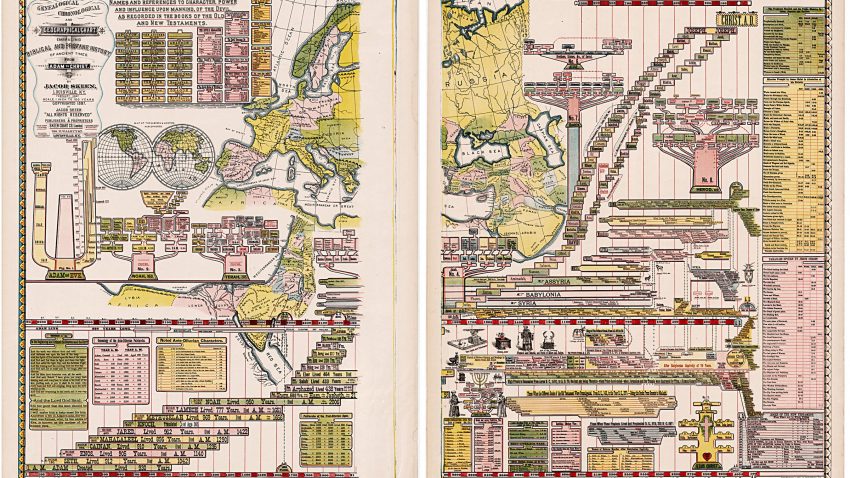
Comments Off on Rare Shaker Timeline/Chart
Filed under Latest News, Uncategorized
The Bowling Green Press (1846)
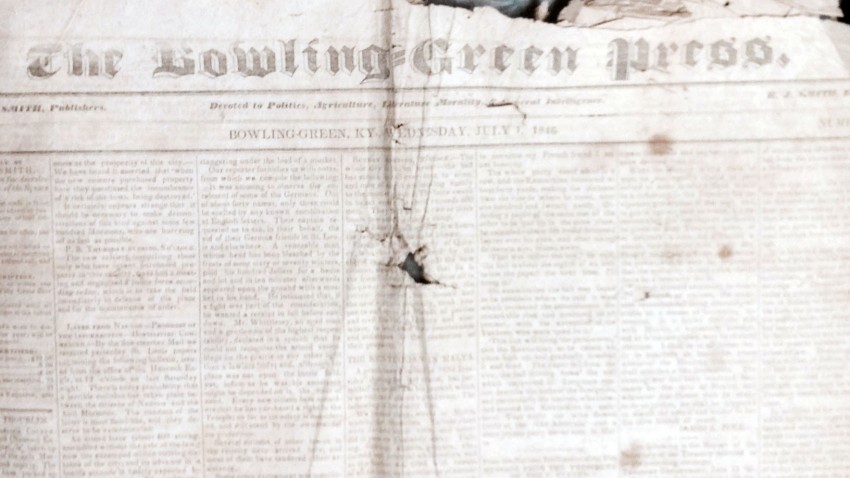 What was happening in Bowling Green, KY on July 1, 1846 almost 170 years ago? Well, now we know! A wonderful, recent donation lets us learn more about Bowling Green’s early history. This very rare newspaper, with the masthead, The Bowling Green Press, is the only one our Special Collections Library staff have seen, and although it is in poor condition; it is definitely preferable to having no specimen at all. The survival of any periodical is a triumph against many odds. We think of our culture as a throw-away culture but newspapers have always be seen as expendable–meant to be read, passed around and then thrown away, or even used for wrapping paper or other household purposes.
What was happening in Bowling Green, KY on July 1, 1846 almost 170 years ago? Well, now we know! A wonderful, recent donation lets us learn more about Bowling Green’s early history. This very rare newspaper, with the masthead, The Bowling Green Press, is the only one our Special Collections Library staff have seen, and although it is in poor condition; it is definitely preferable to having no specimen at all. The survival of any periodical is a triumph against many odds. We think of our culture as a throw-away culture but newspapers have always be seen as expendable–meant to be read, passed around and then thrown away, or even used for wrapping paper or other household purposes.
The newspaper noted under its masthead, that it was devoted to “Politics, Agriculture, Literature, Morality and General Intelligence.” Headlines in the issue focus on the Mormon conflict and controversy at Nauvoo, IL, President James K. Polk and his declaration of war with Mexico and the “Awful Calamity” in Quebec as the Theatre Royal burns killing 50 people. “The Theatre Royal, Saint Lewis [street], took fire from the overturning of a camphene lamp, at the close of the exhibition of Mr. Harlean’s Chemical Dioramas, and the whole interior of the building was almost instantly in a blaze. Local news highlights include the deaths of Mrs. Sarah Cox, 87 of this county and Mrs. George (Adelaide) Milliken of Simpson County, KY in her 30th year. There are a few handsomely illustrated advertisements of products or services offered and they portray many aspects of daily life. Butter was selling for 10 cents per pound, coffee at 9 cents and sugar, 7 cents. Books and “tationary” were for sale at Townsend’s store and the most “fashionable style” hats could be had at William Whiteman’s store. The Louisville Steamer packet, “General Warren,” left regularly at 10:00 every Saturday. Also, if you did not feel well, Dr. S. A. Withrs (sic) requests that you stop by the Green River Hotel or his office across the street from the Market House for treatment.
We are so pleased to have this early Bowling Green, KY newspaper and will preserve it for future historians. You may see this and other items in the WKU Department of Library Special Collections by visiting or by searching TopSCHOLAR and KenCat.
Comments Off on The Bowling Green Press (1846)
Filed under New Stuff
MADISON CAWEIN
The Department of Special Collections recently added a first edition of a book composed of a beautifully illustrated poem by Madison Julius Cawein.
 The poem, “Let Us Do The Best We Can,” is one of the works produced by this prolific Kentucky poet. He was popular in his lifetime (b. March 23, 1865, d. December 8, 1914), but he is not a familiar name to many Kentuckians. He was known as the “Keats of Kentucky,” and acclaimed as the great nature poet of his time. He loved and praised the beauty of the flora and fauna of his native Kentucky and showcased a deep love and appreciation of the same. Cawein said of his poetry that “the dreams which any true poet presents to the world may not be of that imperishable stuff that makes for immortality, but they help humanity for the time being, and that is sufficient, is all he hoped for them; dreams of a beauty that has never died, and that will never utterly perish from the earth, as long as the aesthetic sense is a part of the spiritual nature of man” (Rothert, O.A., 1921, The Story of a Poet.)
The poem, “Let Us Do The Best We Can,” is one of the works produced by this prolific Kentucky poet. He was popular in his lifetime (b. March 23, 1865, d. December 8, 1914), but he is not a familiar name to many Kentuckians. He was known as the “Keats of Kentucky,” and acclaimed as the great nature poet of his time. He loved and praised the beauty of the flora and fauna of his native Kentucky and showcased a deep love and appreciation of the same. Cawein said of his poetry that “the dreams which any true poet presents to the world may not be of that imperishable stuff that makes for immortality, but they help humanity for the time being, and that is sufficient, is all he hoped for them; dreams of a beauty that has never died, and that will never utterly perish from the earth, as long as the aesthetic sense is a part of the spiritual nature of man” (Rothert, O.A., 1921, The Story of a Poet.)
From “Let Us Do The Best We Can”:
Let us do the best we can, I say
and have done with the failures of yesterday:
Let us do our work, whatever it is
Let us do our work, or hit or miss
and the world will take from our hearts its tone
and echo the song that’s in our own,
for happienss lies in the work we do,
whatever it be, or old or new:
And whatever the work, whatever the way,
Let us do the best that we can, I say!
See this book and other poetry written by Cawein at the Special Collections library. Search the collection by using KenCat, TopSCHOLAR and the One Search online catalog.
Comments Off on MADISON CAWEIN
Filed under Uncategorized
That Muhlenberg Sound
WKU’s Department of Library Special Collections recently acquired a rare set of newsletters that highlight the richness of Southern Kentucky Music and the loyalty of its followers. Journalist, author and Muhlenberg County, KY native, Bobby Anderson produced for several years, a newsletter  devoted to “that Muhlenberg sound.” The newsletter, by the same title, was “published every once in a while, and sometimes not that often.” It began in 1994 with Vol. 1, No. 1, featuring discussion of a musical documentary on coal mining, an Everly Brothers festival in Central City, KY and the “Home of the Legends” thumb picking contest winners. Other issues include articles about such varied topics as: a new cassette by the late thumb picker Bobby Barber of Sale Creek TN, Mose Rager Day, “Home of the Legends” thumbpicking open class, Les Haney (former Merle Travis picking buddy) cassettes, National Thumb Pickers Hall of Fame inductions and history. Other issues showcase “behind the scenes” stories such as the tale of how Merle Travis and his wife were married when a couple of other fellows became their “pappies.”
devoted to “that Muhlenberg sound.” The newsletter, by the same title, was “published every once in a while, and sometimes not that often.” It began in 1994 with Vol. 1, No. 1, featuring discussion of a musical documentary on coal mining, an Everly Brothers festival in Central City, KY and the “Home of the Legends” thumb picking contest winners. Other issues include articles about such varied topics as: a new cassette by the late thumb picker Bobby Barber of Sale Creek TN, Mose Rager Day, “Home of the Legends” thumbpicking open class, Les Haney (former Merle Travis picking buddy) cassettes, National Thumb Pickers Hall of Fame inductions and history. Other issues showcase “behind the scenes” stories such as the tale of how Merle Travis and his wife were married when a couple of other fellows became their “pappies.”
See this newsletter and other Southern Kentucky music related items at the Special Collections library. Search the collection by using KenCat, TopSCHOLAR and the One Search online catalog.
Comments Off on That Muhlenberg Sound
Filed under Uncategorized
Mammoth Cave Stereoviews 1866
The Department of Library Special Collections at WKU already has an impressive collection of illustrative material related to Mammoth Cave. These items include glass plate negatives, post cards, guide books, etc. A recent acquisition of a complete set Charles L. Waldack’s 1866 stereo views will greatly enhance these materials as Waldack is the first photographer of the cave. The 42 “Magnesium Light Views in Mammoth Cave” were published by E. & H.T. Anthony & Co. and include scenes of the Hotel, guests, the African American cave guides and many interior shots of cave formations. Waldack, orig inally from Belgium came to the United States in 1857. It was noted that he brought “sunlight” to the interior of the cave by the use of magnesium, so that one of the greatest natural wonders of the world could be seen by many. His biography from a special edition of the “Journal of Speleological History” (2000) notes: “These were the first high quality photographs produced underground in any cave. Waldack was naturalized as an American citizen after his marriage to Mary Tanner (born about 1849) of Kentucky, who was also a photographer. He set up a photography shop at 31 West 3rd Street in Cincinnati and made many excellent views of buildings, streets, and bridges between 1857 and 1873. Most important was his 42 stereo cards of Mammoth Cave. The Anthony series was continuously printed until about 1872, and 12 of the photographs were printed as engravings in the 1870 book, “A Historical and Descriptive Narrative of the Mammoth Cave of Kentucky” by William S. Forwood.
inally from Belgium came to the United States in 1857. It was noted that he brought “sunlight” to the interior of the cave by the use of magnesium, so that one of the greatest natural wonders of the world could be seen by many. His biography from a special edition of the “Journal of Speleological History” (2000) notes: “These were the first high quality photographs produced underground in any cave. Waldack was naturalized as an American citizen after his marriage to Mary Tanner (born about 1849) of Kentucky, who was also a photographer. He set up a photography shop at 31 West 3rd Street in Cincinnati and made many excellent views of buildings, streets, and bridges between 1857 and 1873. Most important was his 42 stereo cards of Mammoth Cave. The Anthony series was continuously printed until about 1872, and 12 of the photographs were printed as engravings in the 1870 book, “A Historical and Descriptive Narrative of the Mammoth Cave of Kentucky” by William S. Forwood.
These stereo views can be seen at by visiting WKU’s Department of Library Special Collections or by clicking on the link to access the images at KenCat.
Comments Off on Mammoth Cave Stereoviews 1866
Filed under Uncategorized
Kentucky Cave Wars
Since the first tourist tract written by Alexander Clark Bullitt in 1844, it seemed everyone wanted to visit the “Mammoth Cave.” He considered such a visit an almost spiritual pilgrimage. “Awe and apprehension soon yield to the influence of the delicious air; and after a time a certain jocund feeling is found mingled with the deepest impressions of sublimity. I recommend all broken-hearted lovers and dyspeptic dandies to carry their complaints to the Mammoth Cave, where they will undoubtedly find themselves ‘translated’ into very buxom and happy persons.”
Mammoth Cave is the country’s 26th national park and contains almost 60,000 acres of land in South Central, KY. But, the entire region, because of our 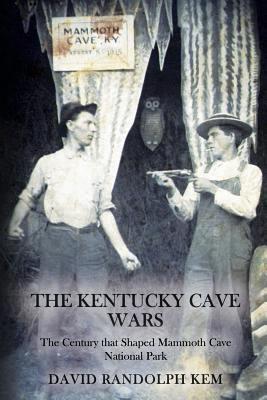 karst topography is riddled with caves. This push for visitors lead to one of the most interesting parts of Mammoth Cave history. It was the period known as the “Kentucky Cave Wars.” It was a time when local cave owners used devious advertising and other illegal means to lure tourists to their underground treasures and away from the “real” cave. They did this impersonating rangers and flagging travelers off the road before they could reach the cave and national park. A recent book by David Kem, The Kentucky Cave Wars: The Century That Shaped Mammoth Cave National Park, delves into this time by “telling the story of Mammoth Cave’s greatest competitors in the late nineteenth and early twentieth centuries. From the death of Dr. Croghan and the first competitors popping up in Cave Country, to the national park’s creation and beyond, more than a century of fighting for tourist dollars shaped the decisions in and around the famous cave.” Kem used several photographs and other illustrative materials from the Kentucky Library Research Collections to illustrate his new book. Find materials about the cave and other subjects in the Department of Library Special Collections by searching TopSCHOLAR and KenCat or request more information from spcol@wku.edu.
karst topography is riddled with caves. This push for visitors lead to one of the most interesting parts of Mammoth Cave history. It was the period known as the “Kentucky Cave Wars.” It was a time when local cave owners used devious advertising and other illegal means to lure tourists to their underground treasures and away from the “real” cave. They did this impersonating rangers and flagging travelers off the road before they could reach the cave and national park. A recent book by David Kem, The Kentucky Cave Wars: The Century That Shaped Mammoth Cave National Park, delves into this time by “telling the story of Mammoth Cave’s greatest competitors in the late nineteenth and early twentieth centuries. From the death of Dr. Croghan and the first competitors popping up in Cave Country, to the national park’s creation and beyond, more than a century of fighting for tourist dollars shaped the decisions in and around the famous cave.” Kem used several photographs and other illustrative materials from the Kentucky Library Research Collections to illustrate his new book. Find materials about the cave and other subjects in the Department of Library Special Collections by searching TopSCHOLAR and KenCat or request more information from spcol@wku.edu.
Comments Off on Kentucky Cave Wars
Filed under General, Uncategorized
Focus On Special Collections
Kentucky Ancestors is a publication of the Kentucky Historical Society which features article topics appealing to family historians of all levels. They have ‘How-To’, Case Studies, and individual family histories as well as Book Notes, stories and commentary. They focus on content related to Kentucky families and locations, as well as those areas from which many Kentuckians migrated. The resource is no longer issued in print but is freely available online. A new feature for the magazine is “Repository Roundup.” They note that “Kentucky has a great reputation for being ‘Records Rich’ – but we want to know WHERE the records are located throughout the state.” We were pleased that the Special Collections Library was chosen as the first library to be featured for this new series. Family historians and other patrons from around the United States and the world visit to see and use the many “books, manuscripts, maps, photographs, audio, video, and other material documenting the history, politics, culture, literature, daily life and folkways” of the families of the Commonwealth and beyond. The article featuring the Special Collections library is available at http://kentuckyancestors.org/repository-roundup-western-kentucky-university/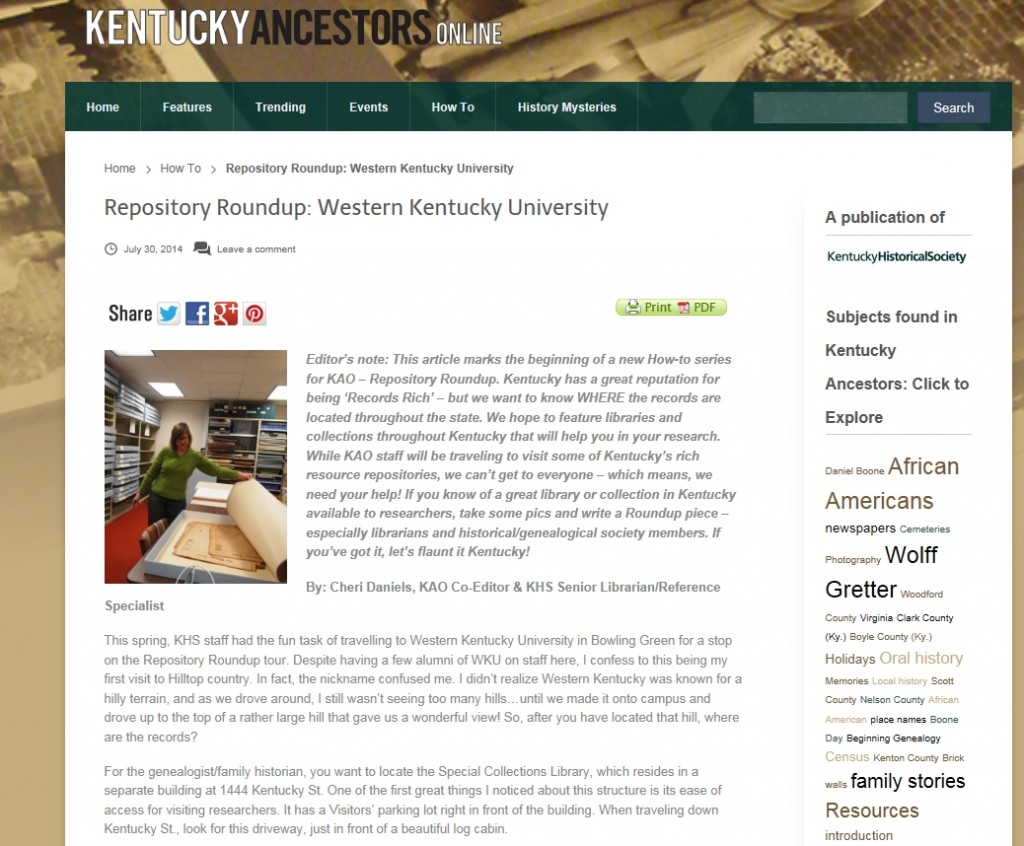
Comments Off on Focus On Special Collections
Filed under New Stuff
A Most Photographed Donkey
Mammoth Cave was and continues to be one of the outstanding scenic attractions in America. It was Kentucky’s first tourist attraction and visitors have been coming since 1816. Many guests stayed in rustic cabins or at the Mammoth Cave Hotel, which was at one time, considered a fine hotel. It was destroyed by fire on December 9, 1916. A newspaper article from the Louisville Times reported: “Mammoth Cave Hotel Destroyed By Fire, Historic Structure Caught Fire From an Unknown Source Early Saturday Morning. The original Mammoth Cave Hotel, a part of which was built in 1811, was entirely destroyed by fire, of unknown origin, which started at three o’clock this morning, consuming the hotel in two hours. All the registers of the hotel and cave, which contained perhaps the greatest collection in existence of the autograph signatures of famous men and women of this country and other parts of the world, were destroyed. The registers of the Mammoth Cave and the Mammoth Cave Hotel, which in part were more than a century old, contained the names of such famous personages as the late King Edward of England, Jenny Lind, Edwin Booth, the Grand Duke Alexis of Russia, and Don Pedro of Brazil.”
The Hotel and cabins were also the background for many photographs. James Davis Rodes is shown posed on the infamous and also well photographed donkey. In our photographic collections, a donkey shows up many times with many different people. James was the son of Judge John Barret Rodes and Elizabeth Hines Rodes. Sadly, he died at an early age in 1914. (Note that some of the Mammoth Cave Hotel registers were not destroyed and are in the Manuscripts Division of the Department of Special Collections.)
To access finding aids for these Mammoth Cave collections, a part of the Manuscripts & Folklife Archives holdings of WKU’s Department of Library Special Collections search TopSCHOLAR and KenCat or email spcol@wku.edu for more information about photographic holdings.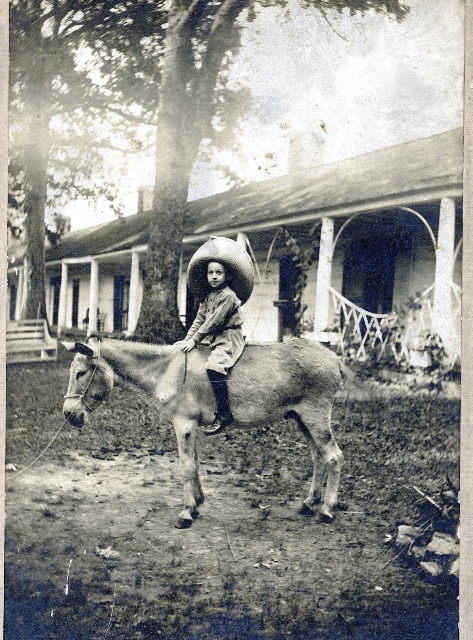
Comments Off on A Most Photographed Donkey
Filed under Uncategorized


